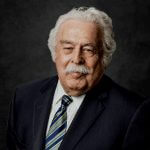Back-to-Back Wins
AWARD: $250,000 and $1.2 million
Case Synopsis
Case Type:
Product Defect
Injury:
Back Injury resulting in early retirement
Defendant:
Chair manufacturer and supplier
Length of Case:
18 months
Case Attorney
 Sanford Rosenblum
Sanford Rosenblum
What makes this case unique:
Two cases 15 years apart, both for police officers injured by chairs that fell apart; defendants in the second case undermined each other during the trial, hurting their overall case.
It’s interesting how one case may lead to another. I was driving a unique high-powered sports car through Delmar, New York, a suburb of Albany: a 1955 Mercedes Gullwing Coupe. It was a rare car, made for only three years before being brought back 50 years later.
At this moment, I was driving well over the speed limit on a backroad when I ran afoul of the police. The officer pulled me over but was immediately more interested in what this car looked like and what it could do than giving me a ticket. We had a nice chat, I got his name, and he drove away without giving me a ticket. Lucked out!
That was 1969. Not too long thereafter, that officer called me and said he had been injured in the office. The chair had broken out from underneath him and he had injured his back.
I investigated the case and sued the chair manufacturer, securing him a settlement of about $250,000.
Fast forward to about 15 years ago. The officer called me again and said a friend of his who was an officer in the Bethlehem Police Department also fell off a chair that broke. He claimed what amounted to a soft tissue injury to his back.
The second officer claimed the injury forced him to retire early. Several different doctors treated him with different therapies. However, nothing helped and it seemed my client was permanently injured.
I filed the lawsuit. We named two defendants. One was the manufacturer involved in building the chair. The other was the manufacturer of a specific part, in this case, the control mechanism that enabled the chair to flex backward.
Our experts believed the control mechanism was faulty. It operated via a lever and tightening system to raise and lower the seat and recline the back. The back of the chair could also be raised relative to the seat. It was a fairly complex system that gave the user control over the ease with which a person could push back on the chair’s back support.
As we tried the case, two things became apparent. The first was that each of the defendants—the chairmaker and the control mechanism maker—were at odds with each other. When examining the witnesses, they kept trying to blame each other. While we had a good case, this tactic was more helpful to us than any evidence we put forth.
The second thing that became clear was that our client’s injury was not well defined.
Our client was being treated by a physician named Dr. Nick Teresi, who did a lot of workers’ compensation cases. He would examine injured workers on behalf of insurance companies and was pretty notorious for being tough on them for their claimed injuries. In short, he had quite a reputation. Some would say that if a worker suffered an amputation, he would tell them, “I’m sure the leg will grow back.”
This worked to our benefit, as he was our client’s physician and was testifying as to the extent of the injury. If anyone could testify about back injuries he could. But while he often sided with insurance companies, he was our expert witness for the claimant. And his diagnosis was that the client would never heal; he would always need medication and therapy. It was truly the reason why the client was forced to retire, according to Dr. Teresi’s testimony, at least.
What is most surprising about this conclusion is that we had no tangible proof of injury, such as a herniated disc, fracture, or otherwise—just “back pain.” If the jury didn’t buy in and didn’t believe this cop was going to live the rest of his life with a sore back, then we would get little or no compensation.
In addition, the cop did not make a sympathetic witness. He was a hardboiled kind of guy. He didn’t get injured while engaged in some physical police activity (like chasing down a suspect); he just fell off a chair. Still, we were able to show that the officer had severely limited mobility, and Dr. Teresi testified as to his back spasms, which were a major source of discomfort.
As we proceeded and the proof of liability became stronger and stronger, the two defendants put their heads together and offered a settlement of $1.2 million. The amount of the settlement was virtually unheard of given the nature of the injury.
The story wound up in the local newspaper, The Albany Times Union, and got picked up by the AP wire service. Soon after, we started getting calls from around the country from attorneys representing people who were also injured from faulty chairs. Of course, we offered to share our file with them.
Dr. Teresi’s son, Joseph, later became a judge and he presided over many cases that I filed. It was he who ruled on our statute of limitations motion for the man who was not informed of his liver cancer, giving us a huge win. He also presided over another case of mine that had lingered in the court system about 15 years before I was brought into the case, revived it, and got the client $9 million. Like his father, Judge Teresi had a reputation for being tough in his cases, but we respected each other very much.












